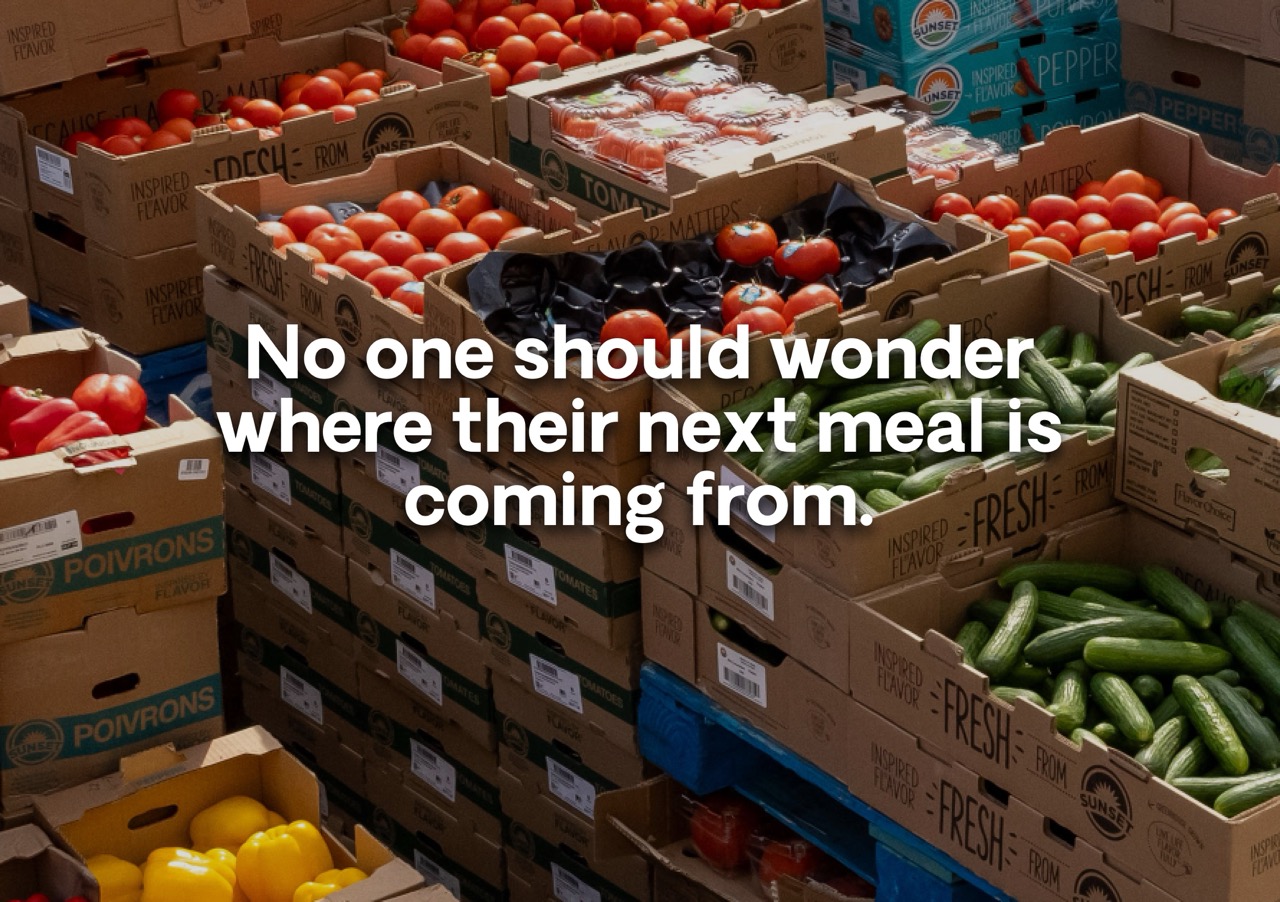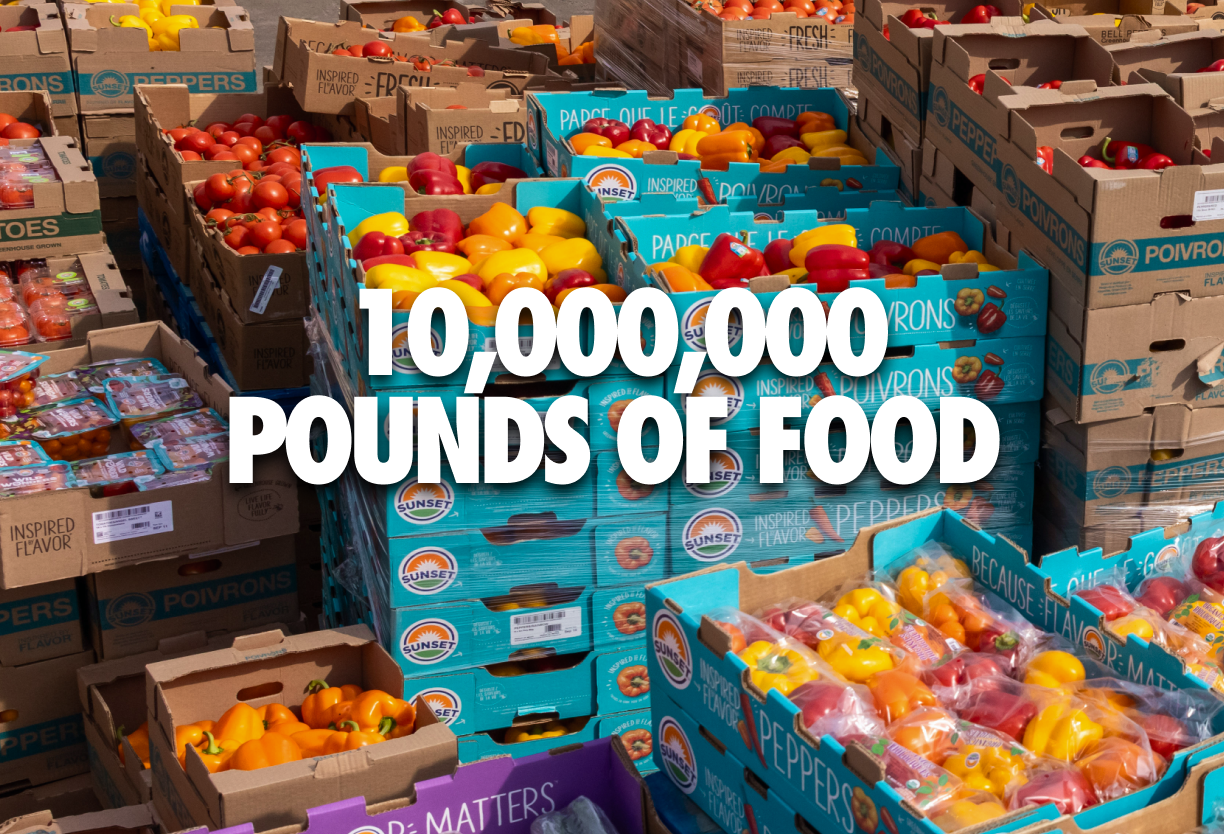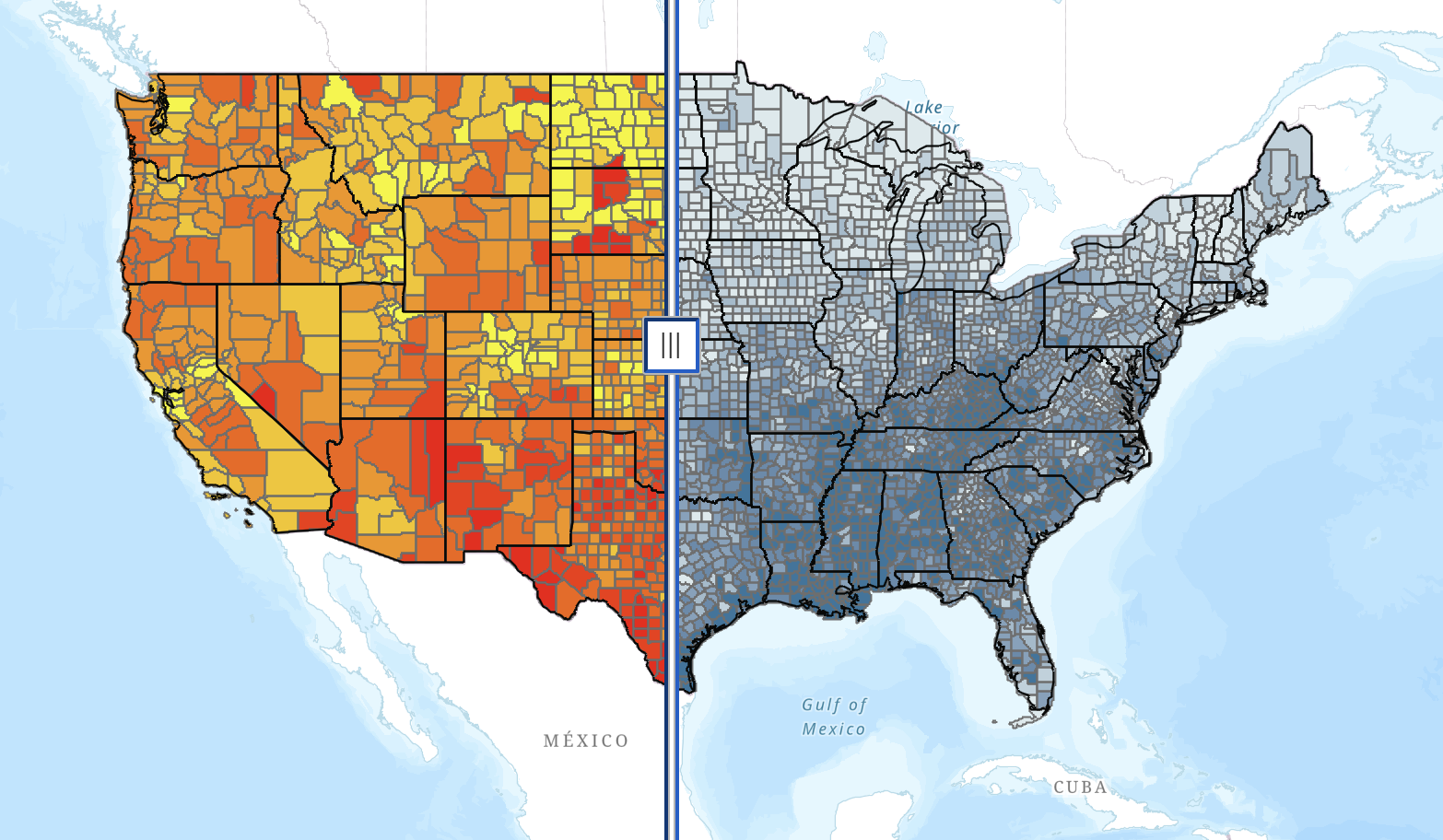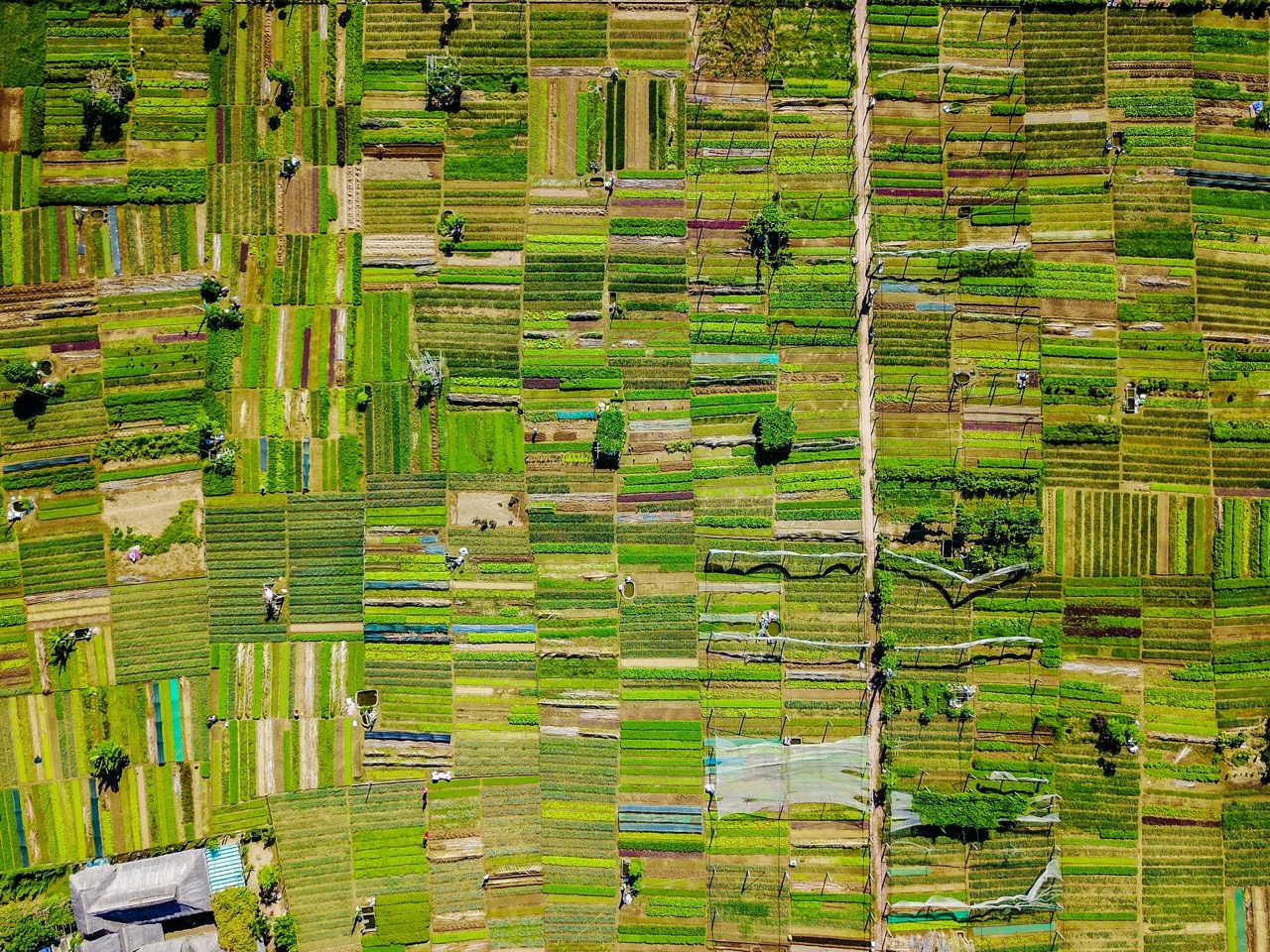What is The Farmlink Project?
The Farmlink Project is a non-profit organization working to make the world’s abundance of produce accessible to everyone. We seek to be the bridge between surplus produce and communities in need. As our Chief Procurement Officer and lifelong food rights activist Luis Yepiz puts it:
“There is a pile of food that is available, but the big issue within the charitable food system in the US is that that pile of food doesn't have anywhere to go. We are a connector, creating bridges between the pile of food and the people that need it the most.”
There is enough food produced today to feed the country two times over, and yet more than 40 million people in the US are food insecure. Farmlink views food insecurity and food waste as challenges that are linked, and aims to solve them together.
What is Farmlink’s story? How does Farmlink do what it does, everyday?

Several groups across Farmlink collaborate to make Farmlink’s mission statement a reality.
Farmlink serves as a conduit for change, connecting partner organizations with one another to effectively fight hunger. Farmlink is a student-founded organization, formed by the collaborative efforts of over 68 fellows and 20 full-time team members based throughout the country – and beyond. Each Farmlinker works mainly under one pillar of our organization – food program, development, operations, or growth – in their day to day operations, while simultaneously supporting other committees in their work. Our leadership team and student colleagues have transformed Farmlink’s impact from a simple kitchen table conversation to a nationwide movement which has salvaged over 100,000,000 pounds of food.
Our primary step in forging these so-called “Farm Links” comes in the form of identifying possible food donation sources and reaching out to them for partnership. When reaching out to potential donors, Farmlink aims to find farm and livestock operations that are forced to put their excess perishable goods to waste. In the early days of Farmlink, during the onset of the COVID-19 pandemic, this process involved Google searches for nearby farms and an endless cycle of cold-calling and emailing. Though simple by nature, this initial outreach was effective in forming relationships throughout the agriculture space and establishing Farmlink as a legitimate source of food recovery. Since its humble beginning, Farmlink has been able to expand the geographic scope and scale of our donor alliances. Our leadership team now attends large national food system conferences and has access to databases aligned with the Produce Market Guide and US Department of Agriculture. While small partners remain endlessly important to Farmlink’s endeavors, we primarily work with acre-verified producers in order to ensure we are filling our trucks with the most food volume possible.
Because the world of food recovery is extremely fast paced and reactive, our food shipments are most often moved within three days or less of the initial deal. Farmlink fellows send the transaction information (including the address of origin and destination, type and mass of produce, and transfer timeline) to our leadership, who then receive quotes from local third party logistic trucking operations. Once quotes have been negotiated and the company selected, the transaction can take place. Our trusted trucking partners move the produce to and from destinations that are pre-arranged by Farmlink’s team.
In searching for food-recipient partners, Farmlink aims to connect with hunger-fighting organizations that align with our mission of true diversity, equity, and inclusion in the food space. Our analysis teams perform a holistic review of the best possible outlets for food donation, prioritizing groups that break down the stigma surrounding food insecurity within their local communities. Moreover, our team minimizes the environmental consequence of such transactions by taking transportation distance heavily into account. Ranging from local churches to nonprofits that serve meals by the million, our recipients vary vastly in size, location, and organizational structure. While 90% of our work is done through larger national food banks like Feeding America, the remainder of Farmlink’s produce is donated in partnership with small community organizations.
What kind of food do we rescue? How much? Where?

Farmlink recovers primarily vegetables and fruits which are nutritious and necessary for a balanced diet. Many food recovery organizations are wary about transporting fruits and vegetables because of their perishable nature. A truckload of produce is like a ticking time bomb; each hour and day is critical for a successful recovery. Farmlink meets this challenge head-on. Our system is highly reactive, delivering food into recipients’ hands before it has passed its prime.
Since its founding in 2020, Farmlink rescues food that would’ve otherwise gone to waste at a 3.2 million pound-per-month pace, as of 2023 reports. Our operation began in California and has since spread across the country. We’ve transported and rescued food in 49 states and are fostering relationships that will eventually make our mission global.
What makes Farmlink different from other hunger-fighting organizations?

We maintain a reactive, hyperlocal system which sets us apart from other food recovery groups. Luis Yepiz said it best: “Most of the food banks in America are regional solutions for a national problem. Farmlink serves as a national solution for a national problem.” We don’t know where the next load of produce is coming from, so we rely on third party transportation to move food no matter where it is – Kansas, Wyoming, Massachusetts, California. This model delivers perishable produce to the people living in the immediate area while containing our carbon footprint.
Farmlink partners with donors throughout the food supply chain: farmers, ranchers, wholesale distributors, shippers, packers, and large produce companies. We know that every point in the pipeline will have excess, and we want to be the first call when donors need to unload that excess. With a traditional food bank network, produce is picked up and sent to a central food bank, then to a smaller community-based organization, and then given to recipients.
We deliver directly from suppliers to the people in need, cutting out one or two middlemen in the process.
We at Farmlink are proud of the strong relationships we foster with our donors and recipients. It’s very important to us to be flexible, to be there when our partners need us, at odd hours of the day and night. We believe maintaining a tight-knit community allows us to best take on our collective responsibility to improve the American food system with dignity and compassion.
What is the financial framework behind Farmlink?
Farmlink is a non-profit operation funded by donations and grants. 50% of our donations come from individual donors, 25% from corporate donors, and 25% from grants. We are grateful to these partners for believing in and sustaining our mission.
Farmlink does not provide direct compensation for farmers and other suppliers to donate their produce. However, suppliers benefit fiscally when they partner with us. First, each hour that a truckload of produce sits on a farm or in a warehouse, it is costing the supplier. When Farmlink takes that excess off their hands, donors save that cost.
Second, we save donors energy and transportation costs associated with dumping excess produce. As Mike Meyer, our head of Farm Advocacy and resident Texan describes:
“Let’s say a distributor has a load of unsold avocados sitting in their facility. People have to take the produce out of the boxes, destroy the boxes, handsort the avocados and repackage. Then you have to landfill the discarded avocados and the old packaging. There are major costs associated with that.”
Farmlink helps its donors circumvent these challenges.
Third, we issue donation certificates for suppliers to receive tax deductions for their role in fighting hunger and food insecurity. We advocate for greater financial advantages granted to those contributing to food recovery. We seek to influence legislation that will allow everybody in the supply chain to take advantage of the tax benefits for donating food.
< Back
What is The Farmlink Project?
The Farmlink Project is a non-profit organization working to make the world’s abundance of produce accessible to everyone. We seek to be the bridge between surplus produce and communities in need. As our Chief Procurement Officer and lifelong food rights activist Luis Yepiz puts it:
“There is a pile of food that is available, but the big issue within the charitable food system in the US is that that pile of food doesn't have anywhere to go. We are a connector, creating bridges between the pile of food and the people that need it the most.”
There is enough food produced today to feed the country two times over, and yet more than 40 million people in the US are food insecure. Farmlink views food insecurity and food waste as challenges that are linked, and aims to solve them together.
What is Farmlink’s story? How does Farmlink do what it does, everyday?

Several groups across Farmlink collaborate to make Farmlink’s mission statement a reality.
Farmlink serves as a conduit for change, connecting partner organizations with one another to effectively fight hunger. Farmlink is a student-founded organization, formed by the collaborative efforts of over 68 fellows and 20 full-time team members based throughout the country – and beyond. Each Farmlinker works mainly under one pillar of our organization – food program, development, operations, or growth – in their day to day operations, while simultaneously supporting other committees in their work. Our leadership team and student colleagues have transformed Farmlink’s impact from a simple kitchen table conversation to a nationwide movement which has salvaged over 100,000,000 pounds of food.
Our primary step in forging these so-called “Farm Links” comes in the form of identifying possible food donation sources and reaching out to them for partnership. When reaching out to potential donors, Farmlink aims to find farm and livestock operations that are forced to put their excess perishable goods to waste. In the early days of Farmlink, during the onset of the COVID-19 pandemic, this process involved Google searches for nearby farms and an endless cycle of cold-calling and emailing. Though simple by nature, this initial outreach was effective in forming relationships throughout the agriculture space and establishing Farmlink as a legitimate source of food recovery. Since its humble beginning, Farmlink has been able to expand the geographic scope and scale of our donor alliances. Our leadership team now attends large national food system conferences and has access to databases aligned with the Produce Market Guide and US Department of Agriculture. While small partners remain endlessly important to Farmlink’s endeavors, we primarily work with acre-verified producers in order to ensure we are filling our trucks with the most food volume possible.
Because the world of food recovery is extremely fast paced and reactive, our food shipments are most often moved within three days or less of the initial deal. Farmlink fellows send the transaction information (including the address of origin and destination, type and mass of produce, and transfer timeline) to our leadership, who then receive quotes from local third party logistic trucking operations. Once quotes have been negotiated and the company selected, the transaction can take place. Our trusted trucking partners move the produce to and from destinations that are pre-arranged by Farmlink’s team.
In searching for food-recipient partners, Farmlink aims to connect with hunger-fighting organizations that align with our mission of true diversity, equity, and inclusion in the food space. Our analysis teams perform a holistic review of the best possible outlets for food donation, prioritizing groups that break down the stigma surrounding food insecurity within their local communities. Moreover, our team minimizes the environmental consequence of such transactions by taking transportation distance heavily into account. Ranging from local churches to nonprofits that serve meals by the million, our recipients vary vastly in size, location, and organizational structure. While 90% of our work is done through larger national food banks like Feeding America, the remainder of Farmlink’s produce is donated in partnership with small community organizations.
What kind of food do we rescue? How much? Where?

Farmlink recovers primarily vegetables and fruits which are nutritious and necessary for a balanced diet. Many food recovery organizations are wary about transporting fruits and vegetables because of their perishable nature. A truckload of produce is like a ticking time bomb; each hour and day is critical for a successful recovery. Farmlink meets this challenge head-on. Our system is highly reactive, delivering food into recipients’ hands before it has passed its prime.
Since its founding in 2020, Farmlink rescues food that would’ve otherwise gone to waste at a 3.2 million pound-per-month pace, as of 2023 reports. Our operation began in California and has since spread across the country. We’ve transported and rescued food in 49 states and are fostering relationships that will eventually make our mission global.
What makes Farmlink different from other hunger-fighting organizations?

We maintain a reactive, hyperlocal system which sets us apart from other food recovery groups. Luis Yepiz said it best: “Most of the food banks in America are regional solutions for a national problem. Farmlink serves as a national solution for a national problem.” We don’t know where the next load of produce is coming from, so we rely on third party transportation to move food no matter where it is – Kansas, Wyoming, Massachusetts, California. This model delivers perishable produce to the people living in the immediate area while containing our carbon footprint.
Farmlink partners with donors throughout the food supply chain: farmers, ranchers, wholesale distributors, shippers, packers, and large produce companies. We know that every point in the pipeline will have excess, and we want to be the first call when donors need to unload that excess. With a traditional food bank network, produce is picked up and sent to a central food bank, then to a smaller community-based organization, and then given to recipients.
We deliver directly from suppliers to the people in need, cutting out one or two middlemen in the process.
We at Farmlink are proud of the strong relationships we foster with our donors and recipients. It’s very important to us to be flexible, to be there when our partners need us, at odd hours of the day and night. We believe maintaining a tight-knit community allows us to best take on our collective responsibility to improve the American food system with dignity and compassion.
What is the financial framework behind Farmlink?
Farmlink is a non-profit operation funded by donations and grants. 50% of our donations come from individual donors, 25% from corporate donors, and 25% from grants. We are grateful to these partners for believing in and sustaining our mission.
Farmlink does not provide direct compensation for farmers and other suppliers to donate their produce. However, suppliers benefit fiscally when they partner with us. First, each hour that a truckload of produce sits on a farm or in a warehouse, it is costing the supplier. When Farmlink takes that excess off their hands, donors save that cost.
Second, we save donors energy and transportation costs associated with dumping excess produce. As Mike Meyer, our head of Farm Advocacy and resident Texan describes:
“Let’s say a distributor has a load of unsold avocados sitting in their facility. People have to take the produce out of the boxes, destroy the boxes, handsort the avocados and repackage. Then you have to landfill the discarded avocados and the old packaging. There are major costs associated with that.”
Farmlink helps its donors circumvent these challenges.
Third, we issue donation certificates for suppliers to receive tax deductions for their role in fighting hunger and food insecurity. We advocate for greater financial advantages granted to those contributing to food recovery. We seek to influence legislation that will allow everybody in the supply chain to take advantage of the tax benefits for donating food.
How the Cake is Made: The Farmlink Process
What is The Farmlink Project?
The Farmlink Project is a non-profit organization working to make the world’s abundance of produce accessible to everyone. We seek to be the bridge between surplus produce and communities in need. As our Chief Procurement Officer and lifelong food rights activist Luis Yepiz puts it:
“There is a pile of food that is available, but the big issue within the charitable food system in the US is that that pile of food doesn't have anywhere to go. We are a connector, creating bridges between the pile of food and the people that need it the most.”
There is enough food produced today to feed the country two times over, and yet more than 40 million people in the US are food insecure. Farmlink views food insecurity and food waste as challenges that are linked, and aims to solve them together.
What is Farmlink’s story? How does Farmlink do what it does, everyday?

Several groups across Farmlink collaborate to make Farmlink’s mission statement a reality.
Farmlink serves as a conduit for change, connecting partner organizations with one another to effectively fight hunger. Farmlink is a student-founded organization, formed by the collaborative efforts of over 68 fellows and 20 full-time team members based throughout the country – and beyond. Each Farmlinker works mainly under one pillar of our organization – food program, development, operations, or growth – in their day to day operations, while simultaneously supporting other committees in their work. Our leadership team and student colleagues have transformed Farmlink’s impact from a simple kitchen table conversation to a nationwide movement which has salvaged over 100,000,000 pounds of food.
Our primary step in forging these so-called “Farm Links” comes in the form of identifying possible food donation sources and reaching out to them for partnership. When reaching out to potential donors, Farmlink aims to find farm and livestock operations that are forced to put their excess perishable goods to waste. In the early days of Farmlink, during the onset of the COVID-19 pandemic, this process involved Google searches for nearby farms and an endless cycle of cold-calling and emailing. Though simple by nature, this initial outreach was effective in forming relationships throughout the agriculture space and establishing Farmlink as a legitimate source of food recovery. Since its humble beginning, Farmlink has been able to expand the geographic scope and scale of our donor alliances. Our leadership team now attends large national food system conferences and has access to databases aligned with the Produce Market Guide and US Department of Agriculture. While small partners remain endlessly important to Farmlink’s endeavors, we primarily work with acre-verified producers in order to ensure we are filling our trucks with the most food volume possible.
Because the world of food recovery is extremely fast paced and reactive, our food shipments are most often moved within three days or less of the initial deal. Farmlink fellows send the transaction information (including the address of origin and destination, type and mass of produce, and transfer timeline) to our leadership, who then receive quotes from local third party logistic trucking operations. Once quotes have been negotiated and the company selected, the transaction can take place. Our trusted trucking partners move the produce to and from destinations that are pre-arranged by Farmlink’s team.
In searching for food-recipient partners, Farmlink aims to connect with hunger-fighting organizations that align with our mission of true diversity, equity, and inclusion in the food space. Our analysis teams perform a holistic review of the best possible outlets for food donation, prioritizing groups that break down the stigma surrounding food insecurity within their local communities. Moreover, our team minimizes the environmental consequence of such transactions by taking transportation distance heavily into account. Ranging from local churches to nonprofits that serve meals by the million, our recipients vary vastly in size, location, and organizational structure. While 90% of our work is done through larger national food banks like Feeding America, the remainder of Farmlink’s produce is donated in partnership with small community organizations.
What kind of food do we rescue? How much? Where?

Farmlink recovers primarily vegetables and fruits which are nutritious and necessary for a balanced diet. Many food recovery organizations are wary about transporting fruits and vegetables because of their perishable nature. A truckload of produce is like a ticking time bomb; each hour and day is critical for a successful recovery. Farmlink meets this challenge head-on. Our system is highly reactive, delivering food into recipients’ hands before it has passed its prime.
Since its founding in 2020, Farmlink rescues food that would’ve otherwise gone to waste at a 3.2 million pound-per-month pace, as of 2023 reports. Our operation began in California and has since spread across the country. We’ve transported and rescued food in 49 states and are fostering relationships that will eventually make our mission global.
What makes Farmlink different from other hunger-fighting organizations?

We maintain a reactive, hyperlocal system which sets us apart from other food recovery groups. Luis Yepiz said it best: “Most of the food banks in America are regional solutions for a national problem. Farmlink serves as a national solution for a national problem.” We don’t know where the next load of produce is coming from, so we rely on third party transportation to move food no matter where it is – Kansas, Wyoming, Massachusetts, California. This model delivers perishable produce to the people living in the immediate area while containing our carbon footprint.
Farmlink partners with donors throughout the food supply chain: farmers, ranchers, wholesale distributors, shippers, packers, and large produce companies. We know that every point in the pipeline will have excess, and we want to be the first call when donors need to unload that excess. With a traditional food bank network, produce is picked up and sent to a central food bank, then to a smaller community-based organization, and then given to recipients.
We deliver directly from suppliers to the people in need, cutting out one or two middlemen in the process.
We at Farmlink are proud of the strong relationships we foster with our donors and recipients. It’s very important to us to be flexible, to be there when our partners need us, at odd hours of the day and night. We believe maintaining a tight-knit community allows us to best take on our collective responsibility to improve the American food system with dignity and compassion.
What is the financial framework behind Farmlink?
Farmlink is a non-profit operation funded by donations and grants. 50% of our donations come from individual donors, 25% from corporate donors, and 25% from grants. We are grateful to these partners for believing in and sustaining our mission.
Farmlink does not provide direct compensation for farmers and other suppliers to donate their produce. However, suppliers benefit fiscally when they partner with us. First, each hour that a truckload of produce sits on a farm or in a warehouse, it is costing the supplier. When Farmlink takes that excess off their hands, donors save that cost.
Second, we save donors energy and transportation costs associated with dumping excess produce. As Mike Meyer, our head of Farm Advocacy and resident Texan describes:
“Let’s say a distributor has a load of unsold avocados sitting in their facility. People have to take the produce out of the boxes, destroy the boxes, handsort the avocados and repackage. Then you have to landfill the discarded avocados and the old packaging. There are major costs associated with that.”
Farmlink helps its donors circumvent these challenges.
Third, we issue donation certificates for suppliers to receive tax deductions for their role in fighting hunger and food insecurity. We advocate for greater financial advantages granted to those contributing to food recovery. We seek to influence legislation that will allow everybody in the supply chain to take advantage of the tax benefits for donating food.
.png)







.svg)
.svg)
.svg)